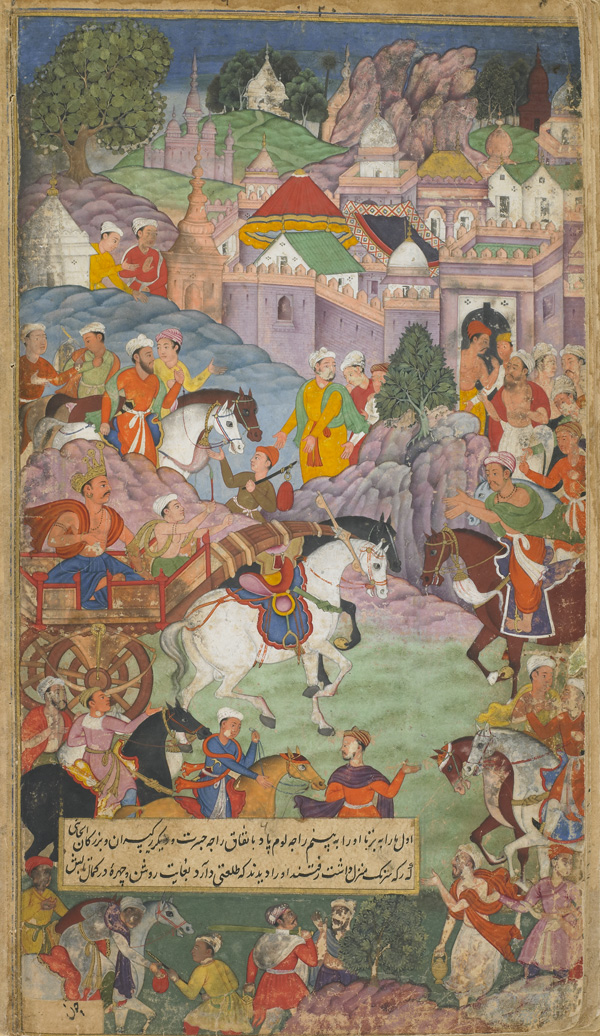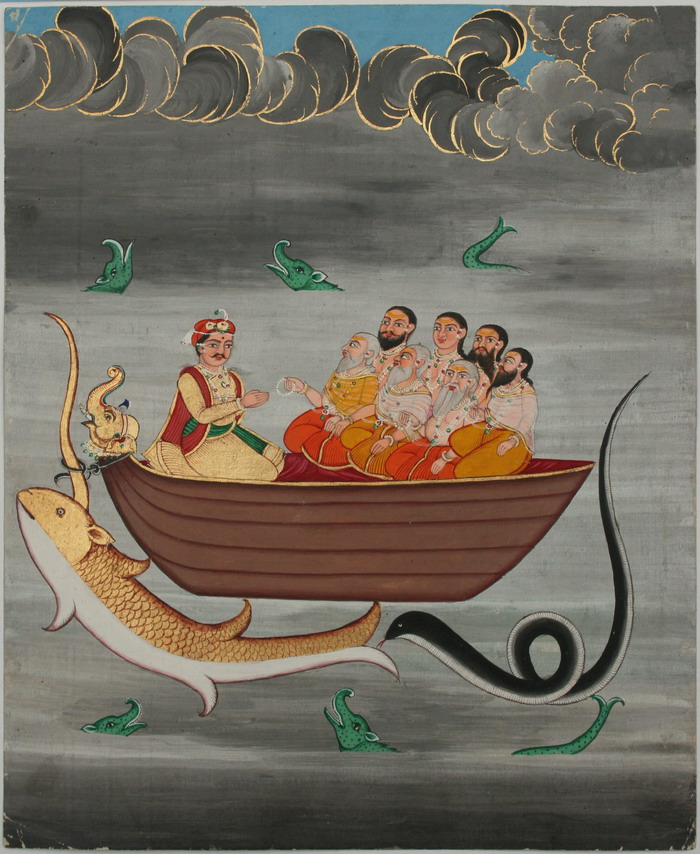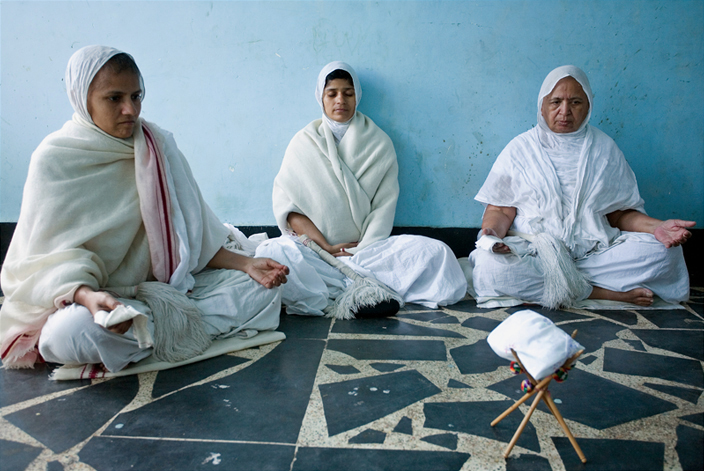|
Rishyasringa
Rishyasringa ( sa, ऋष्यशृङ्ग; ; Pali: Isisiṅga) is a Rishi mentioned in Indian ( Hindu and Buddhist) scriptures from the late first millennium BCE. According to the Hindu epics ''Ramayana'' and ''Mahabharata'', he was a boy born with the horns of a deer who became a seer and was lured by royal courtesans, which led to the yajna (fire sacrifice) of King Dasharatha. His story also occurs in the Buddhist Jatakas, where he is mentioned as the son of Bodhisatta and was tried to be seduced by royal courtesans. Hindu legends The story of Rishyasringa briefly appears in the ''Ramayana'', while a detailed account is narrated in the ''Mahabharata''. Birth According to the ''Mahabharata'', Vibhandaka, a renowned sage and a son of Kashyapa, travels in Mahahrada, when he sees Urvashi, the most beautiful apsara (nymph). Aroused, he emits his seed, which fell into the river. A doe, who is a cursed apsara, swallows it and becomes pregnant due to the sage's miraculous po ... [...More Info...] [...Related Items...] OR: [Wikipedia] [Google] [Baidu] |
Shanta
Shanta is a character in the '' Rāmāyaṇa''. She is the adoptive daughter of King Romapāda of Aṅga and wife of R̥śyaśr̥ṇga. In northern recensions of the ''Rāmāyaṇa'' and later Indian literature, she is the daughter of Daśaratha who is then adopted by Romapāda. Life She was educated in the Vedas, arts, craft as well as in warfare, and was considered to have been very beautiful. One day, while her father, the king Romapada, was busy in conversation with Shanta, a brahmin came to ask for help in cultivation in the days of the monsoon. Romapada did not pay attention to the brahmin's plight. This irritated and enraged the brahmin, who left the kingdom. Indra, the god of rain, was unable to bear the insult to his devotee, so there was little rainfall during the monsoon season resulting in drought in the kingdom. Meanwhile, Dasharatha wanted a son to continue his legacy and enrich his royal dynasty. It was advised that the troubles of both kingdoms could only be ... [...More Info...] [...Related Items...] OR: [Wikipedia] [Google] [Baidu] |
King Romapada
Romapada ( IAST: Romapāda), also known Chitraratha and Lomapada, was a king of Anga, and the adoptive father of Shanta in the Hindu epic ''Ramayana''. Early life Romapada was the youngest son of the Yadava king Vidarbha. Vidarbha had many sons, but his friend King Dharmaratha of Anga was heirless. Thus, Dharmaratha adopted Romapada. When Dharmaratha grew old, he made Romapada the ruler of Anga. Meeting with Rishyasringa After Dharmaratha retired to the forest, Romapada became the King of Anga. He married Vershini, who was the elder sister of Kausalya (mother of Rama). Kausalya's husband - King Dasharatha of Ayodhya was Romapada's childhood friend. Romapada and Vershini did not have any issue; Dasharatha promised them his first child. A daughter Shanta was born to Dasharatha and Kausalya. Shanta was then adopted by the childless Romapada. Once, a Brahmin named Shuvateertha came to Romapada to ask for help, but the king called him back in the evening. When he visited in the ... [...More Info...] [...Related Items...] OR: [Wikipedia] [Google] [Baidu] |
Vibhandaka
Vibhandaka () is a rishi in Hinduism, belonging to the lineage of Sage Kashyapa. His son was Rishyashringa, featured in the epic Ramayana. Legend The Mahabharata states that Sage Vibhandaka once chanced upon Urvashi, the most beautiful of the apsaras. While observing her, he was so aroused that he produced seminal fluid, which fell into some water. The water was consumed by a female deer, after which the creature subsequently became pregnant, and gave birth to a son whom the sage called Rishyashringa, named for the horns upon his head when he was born. Matha According to the Advaita Vedanta, Adi Sankara established four (Sanskrit: ) (monasteries), with the headquarters at Dvārakā in the West, Jagannatha Puri in the East, Sringeri Sringeri (IAST: Śṛngēri) also called Shringeri is a hill town and Taluk headquarters located in Chikkamagaluru district in the Indian state of Karnataka. It is the site of the first maṭha ( Dakshinamnaya Sringeri Sharada Peetham) e ... [...More Info...] [...Related Items...] OR: [Wikipedia] [Google] [Baidu] |
Rishi
''Rishi'' () is a term for an accomplished and enlightened person. They find mentions in various Vedic texts. Rishis are believed to have composed hymns of the Vedas. The Post-Vedic tradition of Hinduism regards the rishis as "great yogis" or "sages" who after intense meditation ( tapas) realized the supreme truth and eternal knowledge, which they composed into hymns.Hartmut Scharfe (2002), Handbook of Oriental Studies, BRILL Academic, , pp. 13–15. The term appears in Pali literature as Ishi and in Buddhism, they can be either Buddhas, Paccekabuddhas, Arahats or a monk of high rank. Etymology According to Indian tradition, the word may be derived from two different meanings of the root 'rsh' (). Sanskrit grammarians derive this word from the second meaning: "to go, to move". V. S. Apte gives this particular meaning and derivation, and Monier-Williams also gives the same, with some qualification. Another form of this root means "to flow, to move near by flowing". (All th ... [...More Info...] [...Related Items...] OR: [Wikipedia] [Google] [Baidu] |
Mahabharata
The ''Mahābhārata'' ( ; sa, महाभारतम्, ', ) is one of the two major Sanskrit epics of ancient India in Hinduism, the other being the '' Rāmāyaṇa''. It narrates the struggle between two groups of cousins in the Kurukshetra War and the fates of the Kaurava and the Pāṇḍava princes and their successors. It also contains philosophical and devotional material, such as a discussion of the four "goals of life" or ''puruṣārtha'' (12.161). Among the principal works and stories in the ''Mahābhārata'' are the ''Bhagavad Gita'', the story of Damayanti, the story of Shakuntala, the story of Pururava and Urvashi, the story of Savitri and Satyavan, the story of Kacha and Devayani, the story of Rishyasringa and an abbreviated version of the '' Rāmāyaṇa'', often considered as works in their own right. Traditionally, the authorship of the ''Mahābhārata'' is attributed to Vyāsa. There have been many attempts to unravel its historical growth ... [...More Info...] [...Related Items...] OR: [Wikipedia] [Google] [Baidu] |
Anga
Anga (Sanskrit: ) was an ancient Indo-Aryan tribe of eastern South Asia whose existence is attested during the Iron Age. The members of the Aṅga tribe were called the Āṅgeyas. Counted among the "sixteen great nations" in Buddhist texts like the Anguttara Nikaya, Aṅga also finds mention in the Jain Vyakhyaprajnapti's list of ancient janapadas. Location Aṅga proper was located between the Champā river to the west and the Rajmahal hills to the east. However, at times, its territories did extend to the sea in the south, or included Magadha in the west. The capital of Aṅga, named Campā, was located at the confluence of the Campā and Gaṅgā rivers, and corresponds to the modern-day villages of Campāpurī and Champanagar in the eastern part of the Indian state of Bihār. According to the s, Campā was also called Kāla-Campā, while Puranic texts claim its ancient name was Mālinī. The other important cities within the Aṅga kingdom included (Sanskrit: ... [...More Info...] [...Related Items...] OR: [Wikipedia] [Google] [Baidu] |
Brahmin
Brahmin (; sa, ब्राह्मण, brāhmaṇa) is a varna as well as a caste within Hindu society. The Brahmins are designated as the priestly class as they serve as priests ( purohit, pandit, or pujari) and religious teachers (guru or acharya). The other three varnas are the Kshatriya, Vaishya and Shudra. The traditional occupation of Brahmins is that of priesthood at the Hindu temples or at socio-religious ceremonies, and rite of passage rituals such as solemnising a wedding with hymns and prayers.James Lochtefeld (2002), Brahmin, The Illustrated Encyclopedia of Hinduism, Vol. 1: A–M, Rosen Publishing, , page 125 Traditionally, the Brahmins are accorded the highest ritual status of the four social classes. Their livelihood is prescribed to be one of strict austerity and voluntary poverty ("A Brahmin should acquire what just suffices for the time, what he earns he should spend all that the same day"). In practice, Indian texts suggest that some Brahmins hist ... [...More Info...] [...Related Items...] OR: [Wikipedia] [Google] [Baidu] |
Indra
Indra (; Sanskrit: इन्द्र) is the king of the devas (god-like deities) and Svarga (heaven) in Hindu mythology. He is associated with the sky, lightning, weather, thunder, storms, rains, river flows, and war. volumes/ref> Indra's myths and powers are similar to other Indo-European deities such as Jupiter, Perun, Perkūnas, Zalmoxis, Taranis, Zeus, and Thor, part of the greater Proto-Indo-European mythology. Indra is the most referred deity in the '' Rigveda''. He is celebrated for his powers, and as the one who killed the great evil (a malevolent type of asura) named Vritra, who obstructed human prosperity and happiness. Indra destroys Vritra and his "deceiving forces", and thereby brings rains and sunshine as the saviour of mankind. He is also an important deity worshipped by the Kalash people, indicating his prominence in ancient Hinduism. Indra's significance diminishes in the post-Vedic Indian literature, but he still plays an important role in ... [...More Info...] [...Related Items...] OR: [Wikipedia] [Google] [Baidu] |
Bhawanrao Shriniwasrao Pant Pratinidhi
Bhawanrao Shriniwasrao Pant Pratinidhi C.B.E (October 24, 1868 – April 13, 1951), popularly known as Balasaheb Pant Pratinidhi or Bhawanrao Balasaheb Pant Pratinidhi, was the ruler of the princely state of Aundh of British Raj during the reign (1909 – 1947). He is known for inventing the exercise sequence of Surya Namaskar, Salute to the Sun, now incorporated into modern yoga as exercise. Life Bhawanrao Shriniwasrao was born to Shriniwasrao Parashuram "Anna Sahib" (7th Raja of Aundh) on 24 October 1868 in a Deshastha Brahmin family. He studied at Satara High School and completed his Bachelor of Arts in Deccan College of University of Bombay in Pune. He ascended the throne as the Raja of Aundh State on 4 November 1909. Although Balasaheb was not a scholar, he was avid reader and his Sanskrit was tolerably good. He worked as Chief Secretary to his father from 1895-1901 in order to learn the Administration of the State. Aundh Experiment The Aundh Experiment was an e ... [...More Info...] [...Related Items...] OR: [Wikipedia] [Google] [Baidu] |
Tapas (Hinduism)
Tapas (Sanskrit: तपस्) is a variety of austere spiritual meditation practices in Indian religions. In Jainism, it means asceticism (austerities, body mortification); in Buddhism, it denotes spiritual practices including meditation and self-discipline; and in the different traditions within Hinduism it means a spectrum of practices ranging from asceticism, inner cleansing to self-discipline by meditation practices. The ''Tapas'' practice often involves solitude, and is a part of monastic practices that are believed to be a means to moksha (liberation, salvation). In the Vedas literature of Hinduism, fusion words based on ''tapas'' are widely used to expound several spiritual concepts that develop through heat or inner energy, such as meditation, any process to reach special observations and insights, the spiritual ecstasy of a yogin or ''Tāpasa'' (a vṛddhi derivative meaning "a practitioner of austerities, an ascetic"), even warmth of sexual intimacy.Kaelber, W. O. (197 ... [...More Info...] [...Related Items...] OR: [Wikipedia] [Google] [Baidu] |
Rama
Rama (; ), Ram, Raman or Ramar, also known as Ramachandra (; , ), is a major deity in Hinduism. He is the seventh and one of the most popular ''avatars'' of Vishnu. In Rama-centric traditions of Hinduism, he is considered the Supreme Being. Rama is said to have been born to Kaushalya and Dasharatha in Ayodhya, the ruler of the Kingdom of Kosala. His siblings included Lakshmana, Bharata (Ramayana), Bharata, and Shatrughna. He married Sita. Though born in a royal family, their life is described in the Hindu texts as one challenged by unexpected changes such as an exile into impoverished and difficult circumstances, ethical questions and moral dilemmas. Of all their travails, the most notable is the kidnapping of Sita by demon-king Ravana, followed by the determined and epic efforts of Rama and Lakshmana to gain her freedom and destroy the evil Ravana against great odds. The entire life story of Rama, Sita and their companions allegorically discusses duties, rights and social ... [...More Info...] [...Related Items...] OR: [Wikipedia] [Google] [Baidu] |



_Bhumi_Puja%2C_yajna.jpg)
.jpg)

